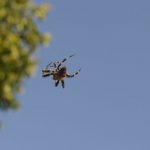 History
History  History
History  Creepy
Creepy 10 More Representations of Death from Myth, Legend, and Folktale
 Technology
Technology 10 Scientific Breakthroughs of 2025 That’ll Change Everything
 Our World
Our World 10 Ways Icelandic Culture Makes Other Countries Look Boring
 Misconceptions
Misconceptions 10 Common Misconceptions About the Victorian Era
 Mysteries
Mysteries 10 Strange Unexplained Mysteries of 2025
 Miscellaneous
Miscellaneous 10 of History’s Most Bell-Ringing Finishing Moves
 History
History 10 Great Escapes That Ended Right Back in Captivity
 Weird Stuff
Weird Stuff 10 Fascinating Things You Might Not Know About Spiders
 Food
Food 10 Everyday Foods You Didn’t Know Were Invented by the U.S. Military
 History
History 10 Most Influential Protests in Modern History
 Creepy
Creepy 10 More Representations of Death from Myth, Legend, and Folktale
 Technology
Technology 10 Scientific Breakthroughs of 2025 That’ll Change Everything
Who's Behind Listverse?

Jamie Frater
Head Editor
Jamie founded Listverse due to an insatiable desire to share fascinating, obscure, and bizarre facts. He has been a guest speaker on numerous national radio and television stations and is a five time published author.
More About Us Our World
Our World 10 Ways Icelandic Culture Makes Other Countries Look Boring
 Misconceptions
Misconceptions 10 Common Misconceptions About the Victorian Era
 Mysteries
Mysteries 10 Strange Unexplained Mysteries of 2025
 Miscellaneous
Miscellaneous 10 of History’s Most Bell-Ringing Finishing Moves
 History
History 10 Great Escapes That Ended Right Back in Captivity
 Weird Stuff
Weird Stuff 10 Fascinating Things You Might Not Know About Spiders
 Food
Food 10 Everyday Foods You Didn’t Know Were Invented by the U.S. Military
Ten Peculiar Times That Scientists Tried to Talk to Animals
Doctor Doolittle famously sang of his urge to talk to the animals. Over the years, many great minds have wanted to do the same. Researchers use advanced technology to become better in tune with the animal kingdom, which ranges from doggy harnesses to AI whale translation. Advances in science have brought us closer than ever in pursuit of interspecies communication. Who knows? You may soon be able to have a chinwag with a beloved pet or go back and forth with a wild beast. Here are ten of the best attempts.
Related: 10 Stories That Prove Animals Are True Masters of Mischief
10 Alex the Parrot’s Astonishing Displays of Intelligence
For 30 years, Dr. Irene Pepperberg taught an African gray parrot to speak and act in ways that transformed our understanding of animal intelligence. Scientists used to believe that birds were not especially clever. But Alex—whose name means African Learning Experiment—quickly proved them wrong. The remarkable bird knew over 100 words to identify objects, colors, and materials. He could even count up to six.
Pepperberg trained Alex using an interactive copying process known as the model/rival technique. This taught him not just to mimic words but to understand their meaning. He could explain the difference between two similar objects, like a metal key and a yellow plastic one, but still knew that both were keys.
Whenever he became bored with exercises, Alex would show off his mischievous side by deliberately giving wrong answers to Dr. Pepperberg’s questions or retorting with a question of his own. After looking in the mirror, he became the first animal in recorded history to ask an existential question. He saw his gray feathers and wondered, “What color?”
Alex died suddenly in September 2007 at 31, young for a parrot. His final words to Dr. Pepperberg as she put him away for the night were, “You be good, see you tomorrow. I love you.”[1]
9 You Can Make Friends with Cats by Blinking
Are any cat owners looking for a way to bond with their pets? Scientists in England reckon you should try narrowing your eyes and blinking at them slowly. A team of psychologists from the University of Sussex found that felines often respond warmly to people with narrowed eyes. It is an expression that cats will often make themselves—a sort of kitty smile that lets them know you are a friend, unlike the threat of an unbroken stare.
The research team created two experiments to test how cats react to people narrowing their eyes at them. In the first experiment, they had cat owners slow-blink at their pets from a meter away. But in the second, it was the scientists themselves who blinked, having never met the cats before. The psychologists found that in both cases, cats who were blinked at were more likely to return the gesture. They also saw that cats were more likely to approach a stranger’s hand who slow-blinked at them.
“It’s a great way of enhancing the bond you have with cats,” study supervisor Professor Karen McComb explained. “Try narrowing your eyes at them as you would in a relaxed smile, followed by closing your eyes for a couple of seconds. You’ll find they respond in the same way themselves, and you can start a sort of conversation.”[2]
8 Horses in Norway Communicate by Pointing
In 2016, scientists in Norway revealed they had figured out a way to communicate with horses. They found that our equine pals can point their muzzles at symbols to, in effect, “talk” to humans. As part of their study, the researchers trained 23 horses, including many different breeds, to touch a board by feeding them carrots.
After this, the horses learned to pick out different symbols on the board if they wanted their blanket taken on or off. The team coached the animals for 10 to 15 minutes a day over two weeks. By the end, all 23 could say if they were feeling too hot or cold by pointing their muzzles. On a sunny day, the horses would tap the vertical bar image, asking humans to remove their blankets. But when it became wet and cold, they would choose the horizontal bar, wanting their blankets to back on.[3]
7 Smart Harness Helps Owners Understand Their Dogs
You cannot teach an old dog new tricks, the adage says. But scientists at North Carolina State University beg to differ. In 2015, they made headlines for developing a smart harness that helps dogs and humans communicate more effectively. The innovative harness came about after a joint project between the tech departments and the canine lovers at the College of Veterinary Medicine.
They devised a high-tech doggy backpack using webcams, sensors, vibrating motors, and other equipment. Handlers use a tablet to command dogs and track their reactions. For example, trainers might tell the harness to buzz to guide their dogs. They can monitor their pooch’s position, heart rate, temperature, and well-being. The North Carolina team says the device could be a key tool for dogs in search and rescue or owners who want to deepen the bond with their pets.
As assistant professor Dr. Alper Bozkurt told reporters, “Our dream is to give people the capability to train their dogs like professionals at home so that the pets can be turned into working animals. For example, for search and rescue, when there’s a big disaster in an urban environment, hundreds of houses collapsed, and there’s only a certain number of trained dogs, so this would give us the capability to train more and more dogs for such purposes.”[4]
6 Yao People and Wild Birds Call to Each Other to Hunt for Honey
Tribal folk in Mozambique have developed a fascinating relationship with wild birds, even coming up with a simple way of speaking. For hundreds of years, the Yao people have teamed up with honeyguide birds to forage for honey.
The two species communicate via calls and chirps. The helpful little birds lead the way to beehives, often hidden high in the trees. The tribespeople then smoke out the insects, crack the nests open, and both species enjoy the sweet treats inside. The Yao folk harvest honey for the tribe, while their feathered friends love tucking into wax combs.
Only recently have scientists started looking into this rare partnership. A 2016 study explored the unique bird call used by honeyguides and Yao people. Researchers were blown away to discover that no one trained birds to scour for hives. The collaboration came about naturally and has been passed on through generations of both species.
“What’s remarkable about the honeyguide-human relationship,” explained lead researcher Claire Spottiswoode, “Is that it involves free-living wild animals whose interactions with humans have probably evolved through natural selection, probably over the course of hundreds of thousands of years.”[5]
5 Kangaroos Ask for Help with Tricky Tasks
A team from Sydney and London found that kangaroos look to humans to ask for help solving tasks. In a 2020 study, researchers set tests that were impossible to complete, like retrieving food from an unopenable box. Most of the marsupials gestured to the scientists for help, with some going over and scratching and sniffing at them to make their point.
Other species are known to ask for help in similar ways, but usually domesticated animals like dogs and horses. This remarkable study suggests that Aussie animals are brainier than scientists once thought. It seems like we are more in tune with the wild than we might have previously believed.[6]
4 Pet Pigs Excel at Human Interaction, Almost as Much as Dogs
Domesticated pigs are great at communicating with humans, almost on par with pet dogs. So say animal behavior researchers in Hungary. The team assembled four-month-old untrained piglets and puppies of various breeds and set them a series of tasks. In the first study, one of the scientists handed out treats every two minutes. Both species happily interacted with the feeder. But when the food stopped, the piglets turned away and broke contact, whereas the puppies carried on gazing at the feeder.
The group also tested both species on how they understood human signals. They set up two containers on the floor, one with food and one without, and had a researcher point at the food-filled one. Only the puppies managed to follow the cue, picking the container with food inside. The pigs, on the other hand, returned to the same side each time.
Scientists say these results are hardly surprising. Canines have been kept as pets for thousands of years longer than their porky pals and are often bred for human interaction. Dogs also react better to visual signals, while pigs tend to communicate by smell. And while they might not be as naturally attuned as pups, pigs are intelligent, adaptable creatures that can be trained to complete complex tasks. Animal scientists have coached several swine to move joysticks and use touch screens with their snouts. That’ll do, pig, that’ll do.[7]
3 Koko, the Celebrity Gorilla that Spoke Sign Language
Koko was an extraordinary primate, loved by many for her impressive communication skills and cheeky character. In sign language, the western lowland gorilla could use over 1,000 words adeptly, plus she had a solid grasp of spoken English. She was confident enough to mix and alter gestures to form new meanings. Born in the San Francisco Zoo, she and other apes learned to sign in the Santa Cruz Mountains. Dr. Francine Patterson taught her the basics in a few weeks.
Along with her intelligence, Koko showed that gorillas have an emotional depth often unseen by humans. She formed warm bonds with her carers, strengthened by their ability to “talk” with each other. She also had a wicked sense of humor, once using sign language to describe a magazine journalist as a toilet.
On June 19, 2018, Koko died in her sleep weeks before her 47th birthday. Her legacy inspires people to learn more about our primate pals and pursue further studies in interspecies communication.[8]
2 Dolphins Fed LSD in Attempt to Speak English
Regulars to Listverse will no doubt be aware of this bizarre NASA-funded project, but it would be remiss of us not to include it here. Researchers gave LSD to dolphins to teach them to speak. John Lilly and his colleagues at the Communication Research Institute thought that dolphins were intelligent and capable animals. They believed lysergic acid would help the creatures find their voice.
In one experiment, he trapped a bottlenose dolphin called Peter in an isolation tank for three months with a female researcher, Margaret Howe Lovatt. The pair were together every moment. But Peter grew randy and made advances towards Ms. Lovatt. It threatened to derail the study. Ms. Lovatt ended up taking matters into her own hands. She used to regularly relieve the animal to get the test back on track.
Despite going to such bizarre lengths, the scientists never managed to chat to a dolphin. They did find that the marine mammals were 70% more vocal after taking LSD. According to Lilly, the sounds made by acid-tripping animals had “no meaning in the verbal sphere.”[9]
1 AI Allows Scientists to Communicate with Humpback Whale
In 2024, researchers on the Whale-SETI project told the world they had “spoken” to a whale for 20 minutes. The team went back and forth with a humpback called Twain off the coast of Alaska. They are now working on using artificial intelligence to understand Twain’s response.
Led by behaviorist Dr. Brenda McCowan, they played whale call recordings on an underwater speaker. Twain swam over to their boat and replied. “We believe this is the first such communicative exchange between humans and humpback whales in the humpback’ language,’” Dr. McCowan explained.
The team is now working to decode the complex patterns in Twain’s response. They are using sophisticated AI techniques like information theory and machine learning. But Whale-SETI does not plan to stop at signals from the ocean depths. Scientists hope to one day apply similar methods to translate messages from extraterrestrial intelligence. If they can untangle whale calls, why not give alien messages a try as well?[10]








